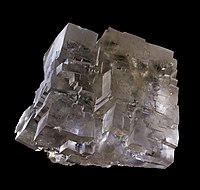
Photo from wikipedia
Purpose Study of corrosion behaviour could benefit from quantum chemical calculation to investigate the role of adsorption of main anions such as OH− and Cl− on metallic surfaces. The purpose… Click to show full abstract
Purpose Study of corrosion behaviour could benefit from quantum chemical calculation to investigate the role of adsorption of main anions such as OH− and Cl− on metallic surfaces. The purpose of this study is to report the quantum chemical study of aluminium immersed in NaOH, NaCl and HCl solutions and verifying the calculations by potentiodynamic and open-circuit potential (OCP) measurements. Design/methodology/approach The electrochemical evaluations based on potentiodynamic polarization and OCP experiments were carried out. For theoretical investigations, the quantum chemical calculation was performed. In this regard, the adsorption of Cl−, OH− and H+ on aluminium surface was investigated. Furthermore, the natural bond orbital for the direction and magnitude of charge transfer interactions was calculated. Findings The calculations indicate that higher interaction energy between ions with the metallic cluster being modelled together with natural bond orbital calculations of direction and magnitude of charge transfer accurately predicts corrosion. Originality/value This paper shows that ions such as Cl−, OH− and H+ cause the corrosion of aluminium in NaOH, NaCl and HCl environments. The overall theoretical data corroborate with experimental results.